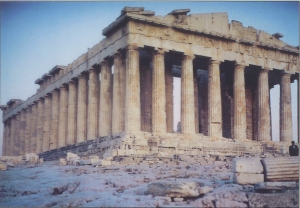The work of the Greeks still lives on today. We have not made such large advancements from what they were doing then. They developed and used the Golden Rule, which is still taught and used today. Their goal of perfection led them to strive and achieve masterpieces of all kinds. The Ancient Greeks believed that Man was an ideal form. In their estimation, Man is the measure of all things. Their works reflect an interest in the naturalistic world. More like reality except that there is an emphasis on the “ideal” figure. This was translated into their architecture as well!!
Classical orders of columns
The Parthenon – a temple in honor of the Goddess Athena – is considered the most glorious building of the ancient world, fully embodying the values of harmony and proportion. It stands on top of the Acropolis of Athens overlooking the city. The Parthenon is constructed almost entirely from marble. It features eight Doric columns in front and back, and 17 columns along each side.
The Theater of Dionysus was first built around 350 BCE, putting it in the Late Classical period of Greek architecture. Before this theatrical performances in Athens probably occurred in the Agora, but at some point someone decided they needed a permanent site and the sanctuary of Dionysus below the Acropolis was chosen as an appropriate spot. It was here that plays by Aeschylus, Sophokles, Euripides, and Aristophanes were performed every year.
The Temple of Athena Nike – part of the Acropolis in the city of Athens. The design of the temple was known as dipteral, a term that refers to the two sets of columns surrounding the interior section.
Greek furniture styles were simple, elegant and tasteful. Although carving and inlays were used, furniture was not over-decorated. Houses were not cluttered with much furniture, and household items were made for use and comfort rather than decoration.
The Greek key is an ancient ornamental motif consisting of a continuous band arranged in rectilinear forms. Greek keys are common decorative elements in Greek art and Roman art; the design is also common in present day architecture as a neoclassical element.
Greeks had a large export business and decorated their containers to help sell their products.
–Geometric Style (c. 900-700 BC) characterized by stylized motifs
–Black Figure (c. 600-480 BC) black coated surface that was scratched into, example: Ajax Commiting Suicide by Exekias, 525 B.C.
–Red Figure (c. 530-450 BC) negative version of Black Figure
–White Ground (c. 450-400 BC) grave ornamentation










Leave a comment